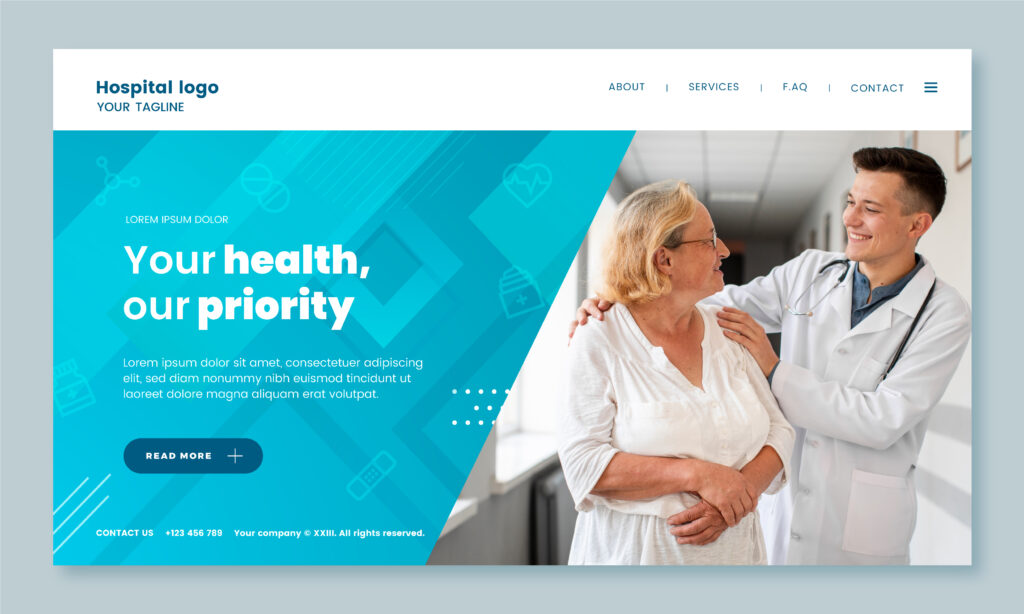Any medical practice, hospital or healthcare provider must have a well-done healthcare website. Proper design of the healthcare website enhances a patient’s satisfaction along with gaining accessibility, engagement and burgeoning trust.
1. User-Centric
UX/UI: The website should have a clean, intuitive, and responsive design for all devices, particularly smartphones and tablets. Use a consistent colour scheme, legible fonts and simple navigation.
Accessibility: Ensure that your website is accessible to all users, including those with disabilities. Compliance with the Web Content Accessibility Guidelines (WCAG) ensures that the site is accessible to users with visual, auditory and cognitive disabilities.
2. Comprehensive Information
About Us Section: Give an overview of the healthcare facility, such as history, mission, values and the team of medical experts and professionals running the place. Introduce the doctors and staff with biographies and their credentials to develop trust.
Servicing: Mention the services and treatments. Use layman’s language and clarify highbrow medical procedures and treatments. Specialization.
Location and Contact Information: Make it easy for patients to locate and contact the clinic with, for example, a location map showing the clinic’s location, the address, phone numbers, email and perhaps an online contact form. If you have more than one clinic, add information for each.
3. Patient Resources
Appointments and Scheduling: Online booking for patients; create user-friendly interfaces, provide the patient with a calendar of months through which he can choose an appointment date with an indication of a doctor by name.
Patient Portal: Allow access to a secure patient portal that can view and navigate medical records, test results, prescriptions and communication with healthcare professionals when needed.
About Health Issues: A blog featuring articles, videos and infographics on various health problems is an excellent method for patient education and to improve SEO for the practice.
4. Safety and Privacy
HIPAA Compliance: Ensure the site follows HIPAA to secure patient data. Security is tight when it comes to the inclusion of SSL certificates and encrypted databases, as well as secure login protocols. Privacy policy: State your privacy policy explicitly and how patients’ data will be used and protected. The key to trust is transparency.
5. Engagement and Communication
Live Chat and Chatbots: Provide live chat support for critical questions, appointments, and essential aid.
Testimonials and Reviews: Added a section for patient testimonials and reviews. This would help build the image of your practice even more with all the positive reviews and encourage new patients to try out services.
Social Media Integration: Allow your website to integrate with your social media profiles. Again, the more patients you keep engaged and interested with you through your different social media sites by updating them consistently, the better it will be for you in your efforts to reach out to more people.
6. Technical Considerations
SEO: Ensure site visibility through search engine optimization by placing critical keywords, meta descriptions and alternative texts for images on the site. All this will help in optimizing the site. Updated content will help with higher rankings within search engines.
Page Loading Speed: Ensure your web page loads quickly. A sluggish website can be frustrating, causing visitors to leave your page fast. Optimize images, effective coding and content delivery networks (CDNs) in a better way.
Analytics and Reporting: Implement analytic tools to track how well the website is doing, user behaviour and engagement. Make sense of the data to improve your website continuously.
7. Professional Aesthetics and Branding
Visual Consistency: Create a consistent visual identity that will align with the brand and favour high-quality images, professional graphics and an almost monochrome colour scheme.
Quality Content: Ensure written content is explicit, correct and professional. Consider using the services of several healthcare content writers or medical writers with experience in health.
The keys to a great healthcare website include sound design, complete information on services, patient-centric features and security measures. With all of this put together, the healthcare practitioner should establish a robust digital presence that does way more than just attract and engage patients; instead, it is the recipe for a better overall healthcare experience. Perhaps one of the most essential tools in a competitive field is a well-designed website.








